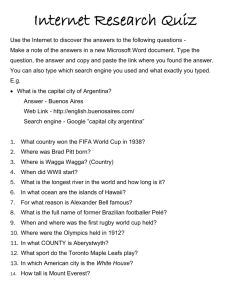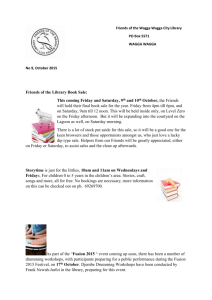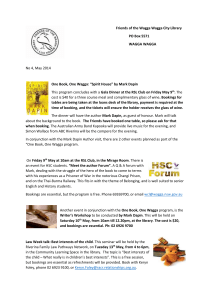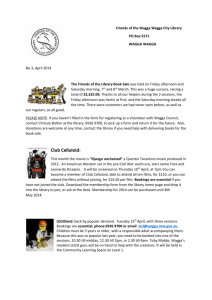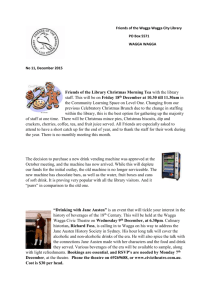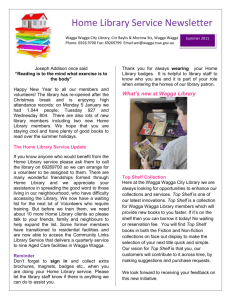Report on a CSU Regional Archives Summer Research Project
advertisement
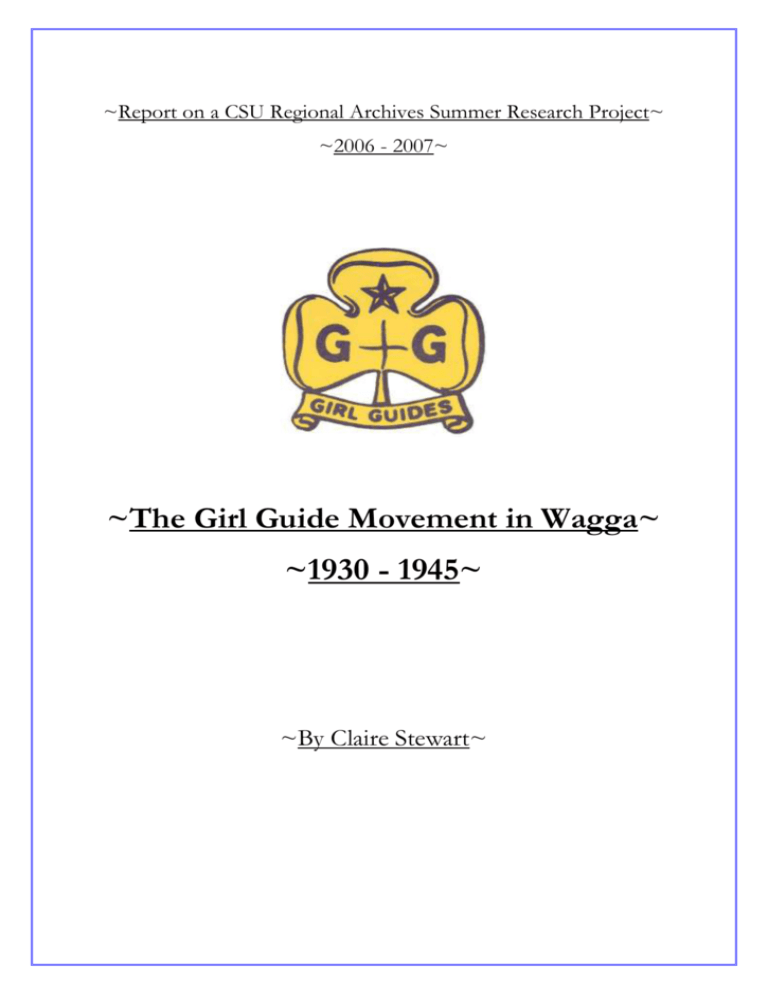
~Report on a CSU Regional Archives Summer Research Project~ ~2006 - 2007~ ~The Girl Guide Movement in Wagga~ ~1930 - 1945~ ~By Claire Stewart~ ~Introduction~ The Girl Guide Association promotes and encourages the development of girls as responsible community members, through a program of activities, service and commitment to the Guide Promise.1 This report will look specifically into the formation of the Wagga branch of the Girl Guides Association of Australia, detailing how the unit was begun, and identifying some of the people involved. The war years, 1939-1945, will also be looked at in detail, to understand the role that the Guides played in the community and the contribution they made towards the war effort in Wagga, Australia and the Empire. Sources used in this report include meeting minute books, radio transcripts, and scrapbooks to name but a few. The Girl Guide Movement grew out of the Boy Scouts; both are international organisations with members in over a hundred countries, and approaching their 100th Birthdays, in 2008 and 2010. While 2007 sees the 150th year since the birth of the founder Lord Baden-Powell, a man with personal integrity and vivid personality, his own life read like a book of adventure appealing to all small boys, and he was precisely the right man to lead a youth movement.2 Scouting and Guiding quickly spread to Australia, and within twenty years of the birth of Scouts in England, Wagga Wagga had its own Scout Companies and its first Guide Company was in the process of being established. As it was reported in 1933, “there is a romance and determination behind the story of the Girl Guide Movement. And it is appropriately named “movement” for the Association has moved forward with the times, expanding in activities and numbers through the years by reason of the absorbing interest and the desire of the members for the development of body, mind and spirit.”3 1 Linley Bartlett. Australian Guide Handbook. (1992) p.1. RW2028/471 CSU Regional Archives. Scrapbook: Daily Advertiser B-P of Gilwell Passes: Worker for World Brotherhood (January 1941) 3 RW2028/469 CSU Regional Archives. Scrapbook: Newspaper clipping, publication unknown (23 rd September 1933) 2 2 ~BACKGROUND~ ~Girl Guide Movement~ The Girl Guide Movement grew out of the Boy Scout Movement which had been formed in 1907 by former soldier Lord Robert Stephenson Smyth Baden-Powell, who had been distinguished in the Boer War (See: Appendix A). The Scout Movement grew out of BadenPowell’s experiences in Africa, and is a movement which teaches young boys various skills in the outdoors intending to mould them into capable men and citizens of the world. When the Boy Scouts held their first big Rally in 1909 at Crystal Palace, London, a handful of girls also attended, informing Baden-Powell: “Please Sir, we are the Wolf Patrol of the Girl Scouts, and we want to do Scouting like the boys.”4 It is from these girls that the Girl Guide Movement began. With the help of his sister Agnes, Baden-Powell established the Girl Guide Movement officially in 1910 and by the end of the year some 8000 girls had enrolled as Guides. Guiding quickly grew and spread throughout Britain and the Empire, within ten years boasting 322,133 members. By 1930 there were over a million Guides in over forty countries worldwide, including the newly established Guide Company in Wagga Wagga, NSW. ~Guides in Australia~ There are many conflicting sources about the origins of Girl Guides in Australia (See: Appendix C). Some claim that Guides reached Australia only a year after its official beginning in Britain. There are many stories of unofficial companies forming in the pre-war years through to the 1920s when Guides were officially begun in New South Wales. There are stories of unofficial groups with names such as Girl Peace Scouts, and the Australian League of Girl Aids. These groups were formed as the youth of the nation wanted to be involved in the growing Guide Movement, even though it hadn’t yet reached Australian shores itself. The 1st Hawthorn Company in Victoria claim to have been the first officially formed in Australia in February 1911 with the full name: ‘Baden-Powell Girl Guides.’5 Also in Victoria, Wynifred Gipps, aged 17, of South Yarra, had started the Florence Nightingale Girl Aids, which later changed to the official Girl Guides. Originally refused a warrant as a Guide Leader as being too young, when Wynifred reached the age of 21, in April 1912, she became the first warranted Guide Leader in Australia.6 4 E.E. Reynolds, The Scout Movement (London: 1950) p.68. Linley Bartlett, Australian Guide Handbook, (1992) p.11. 6 Linley Bartlett, Australian Guide Handbook, (1992) p.11. 5 3 The Girl Guide Movement was spreading rapidly; in 1912 when Baden-Powell visited Australia as part of his World Tour, he was met by Guides in four states. However it wasn’t until 1920 that the first official Guide Companies in New South Wales were formed. In August the Governor’s wife, Dame Margaret Davidson, invited Miss Nella Levy to commence the Girl Guide Movement in NSW. Nella had been a Patrol Leader in an English School Company of Guides during the War, with a copy of “Girl Guiding” and another of “Rules and Policy” as her only aids to forming the NSW branch of Girl Guides.7 The Ballroom at Government House, Sydney, in September 1921 saw the enrolment of the first twenty-six Guiders and the formation of the first sixteen Companies of Girl Guides in NSW. By 1922 each state had set up its own headquarters and appointed a Secretary and a State Commissioner, who was usually the wife of the Governor. 8 By 1927 there were 16,925 members of Guides in Australia. However the formation of a Guide Company in Wagga Wagga was yet still a few years away. ~WAGGA WAGGA GIRL GUIDES ASSOCIATION~ ~Formation of Guides in Wagga~ Boy Scouts had been present in Wagga since the First World War, meeting in an old tin shed on the corner of Berry and Forsyth Streets.9 In 1929 when the second Boy Scout Group was formed, the Guide Movement first reached Wagga. According to Press reports, previous attempts had been made to establish Girl Guides in Wagga, but they had failed, though for what reason it is unknown. Guide Companies had been formed throughout the Southern NSW Division during the 1920s in Albury and surrounding areas. It was in September 1929 that the first successful moves were made for the formation of a Girl Guide Company in Wagga. A meeting was held in the Town Hall with Mayoress Mrs E.E. Collins presiding. Mrs Collins was interested in the Girl Guide Movement and was the first to take steps towards beginning the movement in Wagga. At the meeting it was stated that a company could only be formed with a Guiding Commissioner present. Mrs Welch, who had been involved in Guiding in England before coming to Wagga in 1925, acted as Secretary at the meeting and contacted Mrs Clive Fairbairn, of Holbrook, who was Divisional Commissioner for Southern New South Wales.10 Mrs Fairbairn visited Wagga on September 25th to establish the Wagga Guide Company, also to address the parents and girls of Wagga in the 7 RW2028/566 CSU Regional Archives: Short History of Guiding in NSW. Linley Bartlett, Australian Guide Handbook, (1992) p.12. 9 Sherry Morris, Wagga Wagga A History (Wagga Wagga: 1999) p.188. 10 CSU Regional Archives. Daily Advertiser. (24th September 1929) p.2 8 4 evening, with visits to various schools the following day talking about the Guide Movement. Mrs Jean Lusher, wife of Alderman E.F. Lusher, presided at the meeting on the 25th, as Mrs Collins was away in Sydney for some weeks. It was at this meeting that the women of Wagga interested in the Guiding Movement formed the first Local Association, with Mrs Collins as President, and Mrs Lusher elected to the role of Wagga District Commissioner.11 Interested women were encouraged to train to become Guide Leaders, women who could teach the girls all the skills they required to reach their full potential, as Guides and as citizens of the world. The training was carried out throughout 1930 via correspondence with Sydney Headquarters, along with fortnightly meetings held in Wagga. On November 25th 1930 the first Annual Meeting was held, at which it was announced that Mrs Vera Davidson had qualified as Captain, while Miss Eileen Hall had passed her Lieutenants test. Kath Cussens would sit her Lieutenants examination in early 1931. Jean Garling had completed her Tenderfoot and been enrolled as a Girl Guide. With this news it was clear to Mrs Collins, Mrs Fairbairn and the Local Association that there was now nothing stopping the formation of a Girl Guide Company in Wagga. On 6th December 1930 the very first meeting for the 1st Wagga Girl Guide Company was held, at which there were nine prospective Guides. Numbers soon expanded, and ten girls made their promise and became Wagga’s first Girl Guides at the first enrolment on 14th February 1931 performed by Mrs Lusher, assisted by Jean Garling, who was by that time Company Captain.12 The popularity of the Guides increased, within a few months Wagga saw another enrolment as nine girls made their promise, and received their own Guide Badges to become fully-fledged members of the worldwide sisterhood of Guiding. Prior to the formation of the Wagga Guide Company it was noted that for the Movement to be satisfactory they required a steady growth. The Daily Advertiser reported in late 1931 that there had been an overall increase in the number of Girl Guides in NSW, with numbers now reaching 7000, which “was splendid in view of the effects of the economic and political situation of the country, and it was proof of the soundness of the movement that it could show such growth in spite of adverse circumstances.”13 This overall increase in numbers was mirrored in the Guide Movement in Wagga which also grew steadily. Within twelve months the 1st Wagga Company was full. Before the end of another year two more Companies had formed, along with the 1st Wagga 11 CSU Regional Archives. Daily Advertiser. Troop Formed. An Enthusiastic Meeting. (26th September 1929) RW2028/467 CSU Regional Archives. Scrapbook: Daily Advertiser. Girl Guides Group formed at Wagga, Ten Girls Enrolled (14th February 1931) 13 RW2028/467 CSU Regional Archives. Scrapbook: Daily Adverstiser Second Annual meeting: Officers elected: Reports show excellent progress (18th November 1931) 12 5 Brownie Pack, which had one of the first Guides, Edna Buckman, as Brown Owl. Important to the growth of Guides in Wagga was the formation of the new Murrumbidgee Division in 1933, which centred upon Wagga and encompassed all towns and districts within a seventy mile radius. Mrs Lusher was appointed to the position of Divisional Commissioner as well as her previous role of District Commissioner, at least until a replacement for that position could be found. Guides in Wagga grew rapidly due to the people involved in the movement. In 1929 the Mayoress herself, Mrs Collins, was deeply involved in the formation of Guiding in Wagga, being responsible for the public meeting held to interest the people of Wagga in Girl Guides. Another prominent name in Wagga society during the 1930s was Mrs Jean Lusher, wife of the Alderman and solicitor Edwin Fenn Lusher. Mr Lusher had come to Wagga in 1926 with his family, and soon gained a position in the local community, holding the position of Alderman from 1928 until 1937 including the role of Deputy Mayor in 1929-31.14 Mrs Lusher accepted the role of District Commissioner for Wagga Guides in 1929 and in 1933 also became Divisional Commissioner of the new Murrumbidgee Division. Mrs Lusher’s daughter, thirteen year old Evadne, also became involved in Guides in Wagga, being amongst the second enrolment of the 1st Wagga Guide Company on April 10th 1931. A few years later Evadne left Wagga but continued her involvement in Guiding, transferring to the 1st Moss Vale Company in February 1933.15 Mrs Lusher continued to play an important part in Guiding in Wagga until she left in March 1939 to move to Sydney. ~Activities Wagga Girl Guides Engaged in~ The Wagga Guides took part in a variety of activities during the early years of their company, travelling to various places to take part in Rallies and Guides’ Own services. The Guides also held events to raise money for their Company funds, such as sports days, stalls, fêtes, concerts, dances and picture benefits. The first fundraising event the Guides held was a card party at the home of Mrs Lusher. Sixty guests attended the event, and a substantial amount of money was raised. The large number of guests and the amount of money raised demonstrate the way in which Guiding in Wagga was being enthusiastically supported by the Wagga community. The Wagga Guides also actively took to their part in the worldwide sisterhood of Girl Guides. The Wagga Guides grew quite rapidly and took part in state wide activities as soon as they formed. The first Rally attended by Wagga Guides was held in 14 15 Sherry Morris. Wagga Wagga A History. (Wagga: 1999) p.162, 264. RW2028/153 CSU Regional Archives. The Girl Guide Record Book: 1 st Wagga Company. 1931 6 April 1931, when sixteen Guides departed for Melbourne under the supervision of District Commissioner, Mrs Lusher. The Rally and Guides’ Own were held at the Melbourne Cricket Ground where 16,000 Guides and Scouts welcomed the Chief Scout and Chief Guide, Lord and Lady Baden-Powell who were visiting Australia at the time.16 In August 1931 Mrs Lusher presented the 1st Wagga Guide Company with their Company Colours: the Union Jack. The Union Jack was presented rather than the new Australian Flag due to its long tradition with the British Empire which it represented and to which Australians still felt a sense of loyalty, even thirty years after Federation. At the presentation ceremony all thirty-two members of the 1st Wagga Guides were present. Divisional Commissioner Mrs Fairbairn donated the flag; but unfortunately could not attend the presentation held in the Town Hall. Mrs Lusher presented the flag to the Guides, while Reverend Dr Gunn and the Venerable Archdeacon West conducted the Ceremony, with the flag blessed by Archdeacon West, who was often present at the important events during the early history of the Wagga Guides, providing Spiritual Guidance and confirmation of the community support for the Guide Movement. Mrs Lusher presented the flag to the 1st Wagga Guides with the words: “This is no common flag which I am committing to your keeping. A colour is a sacred ensign. It is the emblem of duty, the outward sign of your allegiance to God, your Sovereign, your country and the Guides, to be looked up to, to be venerated, and to be passed down untarnished to succeeding generations. Accept therefore, on behalf of your company, this flag, remembering the purpose for which it is blessed, the cause of which it is the symbol, and the honour in which it is held.”17 In the latter part of 1932 the Wagga Guides began to hold their own Guiding activities, rather than attending those held by Albury and other Companies. From September 9th till the 12th Wagga Guides held their first camp. The camp was held at “Pomingalarna,” just outside of Wagga, with Miss J. Thewlis of Albury as Camp Commandant. The camp was a great success with the Venerable Archdeacon West attending in order to run the Guides’ Own service, which was held under one of the largest trees. Later in the month the Wagga Guides held their first Rally in the grounds of Church Lodge, Athol Street. Fifty-nine Guides 16 RW2028/467 CSU Regional Archives. Scrapbook: Daily Advertiser, Wagga Girl Guides to Take Part in Melbourne Rally (April 1931) 17 RW2028/467 CSU Regional Archives. Scrapbook: Daily Advertiser, Presentation of Colours to 1st Wagga (22nd August 1931) 7 attended from 1st Wagga, 2nd Wagga (Anglican) and 1st Narrandera Guide Companies, accompanied by twenty-six members of the 1st Wagga Brownie Pack. The Girls were addressed by Bishop Radford who told the girls about the beginnings of Scouting and Guiding in England, which had now reached its twenty-first birthday.18 Holding events of their own led to the Wagga Guides placing themselves before the public on more occasions. Guide Rallies were open to the public, where the Guides would parade, hold stalls and competitions, play games and perform stunts, for their own entertainment as well as demonstrating the aims and objectives of Guiding to the general public, while encouraging others to become involved in the movement. Throughout the later years of the 1930s the Wagga Guides continued to attend camps and rallies in Wagga and the surrounding areas as the Guide Movement continued to grow and flourish. An important aspect of the Girl Guide Movement is “Service for Others,” an ideal which proposes that Guides are at all times available to help others in the community in need of their assistance.19 The Wagga Guides got involved in this part of their program from their earliest days. During the first few years of the existence of 1st Wagga, the Depression was in full swing, so the Guides carried out service to help the unemployed and disadvantaged people in Wagga. The twenty-nine Guides of 1st Wagga did their first significant service for the community in the winter of 1931 when they knitted some forty-eight articles of babies and children’s clothing, including underwear, jumpers, booties, caps and nightdresses, which were then distributed by District Commissioner Mrs Lusher, to those in Wagga who needed them most. This act demonstrates the way in which the girls were involved in the spirit of Guiding, doing their “one good deed a day.”20 Early in 1932 the Guides also mended hymn and prayer books for the Presbyterian Church in repayment for the use of their hall for their weekly meetings the previous year.21 Throughout the 1930s the Wagga Guides continued to carry out service in the community. In July 1938 the Wagga Guides held a fête to raise money to have the name of Wagga delineated in concrete at the new Aerodrome; the Guides raised ₤19/0/9.22 The amount of service carried out by the Guides did of course increase during the war years when the Guides helped to raise money for the war effort. RW2028/467 CSU Regional Archives. Scrapbook: Daily Advertiser Guides’ Rally (26th September 1932) RW2028/467 CSU Regional Archives. Scrapbook: Daily Advertiser Second Annual meeting: Officers elected: Reports show excellent progress (18th November 1931) 20 RW2028/467 CSU Regional Archives. Scrapbook: Daily Advertiser, Wagga Girl Guides Help Needy (1932) 21 RW2028/146 CSU Regional Archives. Court of Honour Minute Book- 1931-1932 (7th March 1932) 22 RW2028/469 CSU Regional Archives. Scrapbook: Daily Advertiser, Guides”Airport” Fete. (July 28th 1938) 18 19 8 ~Wagga Girl Guides during the War ~1939-1945~ On 3rd September 1939 war broke out in Europe. That evening over the wireless the Australian Prime Minister told listeners that it was his melancholy duty to confirm officially that Britain was at war with Germany, and that “as a result, Australia is also at war.” 23 With the outbreak of the Second World War the majority of the Guides activities became centred on war work. The Wagga Guides were living in a town which quickly became a key centre in the Federal Government’s defence plan.24 The depression of the early 1930s had hit the people of Wagga quite hard, and though things were getting better by 1939, unemployment was still high; however the outbreak of the war gave some relief. The war provided employment, local citizens were provided with many opportunities to contribute to the war effort, a munitions factory and an electric lamp factory were quickly set up in Wagga.25 While not actually living in a war zone, nor having to dodge bombs to deliver despatches as English Sea Ranger Pamela McGeorge was doing for the WRNS,26 the Girl Guides of Wagga, as with the rest of Australian Guides, and indeed those in the entire British Empire, found it had become their duty to do as much as they could for the war effort. While Guides were not allowed to get involved in war activities as the Scouts were doing – of which no details could be found – they continued to hold fundraising events, and to collect scrap rubber, silver paper and used stamps, etc, which could be put to use in the war effort. In 1940 the Guides of the Empire set up a fund with an aim of raising ₤20,000 to purchase an air ambulance for the Royal Air Force, and some motor ambulances for the Royal Navy. Within months of the outbreak of war, on 2nd May 1940, when presented with a ₤14 cheque for the Empire War Fund, Assistant State Secretary Miss Olive Kelso King told the Wagga Guides that “the time has come when women have to take their place in world affairs and it will be our duty to assist in re-building the world. The time was when women closed the door against world affairs and stayed at home, but we now have to share in making the world better.”27 With these words of encouragement the Guides of Wagga continued their work towards the war effort, raising money and sending goods to Sydney for use in the war machine or despatch to England. The Guides could be quite proud of their efforts as the money they raised contributed towards the ₤48,000 the Guides of the Empire raised in just 23 Stuart Macintyre, The Oxford History of Australia, The Middle Way. 1942-1995. Vol 5. (Melbourne: 2006) p.325. 24 Sherry Morris, Wagga Wagga A History (Wagga Wagga, 1999) p.191. 25 Sherry Morris, Wagga Wagga A History (Wagga Wagga, 1999) p.191. 26 RW2028/111 CSU Regional Archives. 2WG Radio Transcripts, Trixie Read (27 th December 1941) 27 RW2028/471 CSU Regional Archives. Scrapbook: Daily Advertiser, Assistant Commissioners in Wagga, Address on Movement, Presentation for Empire Fund (2nd May 1940) 9 three months, with ₤3000 contributed by Australian Guides. With the money raised the Armed Forces were able to purchase the Air Ambulance for the RAF, a Motor Ambulance for the Navy, Rest Rooms for the Army and some life boats, one of which was in use at Dunkirk (May 27th-June 4th 1940). Though damaged in the mass evacuation, the lifeboat was repaired and renamed the ‘Guide of Dunkirk,’ after the Guides of the Empire who made its purchase possible.28 The money the Guides raised also went towards mobile kitchens for the homeless and hungry people in Britain, quite an impressive achievement. Again in 1942 the Guides of NSW set themselves the task of raising money for the Government to purchase parachutes for the Australian Airmen, with each parachute costing ₤65. In little more than a month the Guides of Wagga and NSW raised some ₤300, enough to purchase four parachutes. The next target was for the Guides to raise money to purchase wireless transmitting and receiving sets for the Army.29 During the war years Wagga Guides did lose many of their older members, girls joined the VAD and other services, while Guide Leader Joan Cameron left Wagga in order to join General McArthur’s secretarial staff in Melbourne.30 Women who had been Guides were often of great use in other services during the war, due to their training, courage and readiness for whatever faced them. Trixie Read, Captain of 1st Wagga Company, and quite prominent in Wagga Guiding from its earliest days, presented radio broadcasts to the Guides of Wagga on 2WG during the war years. In these broadcasts Trixie often reported the stories of Guides overseas and their acts of courage during times of hardship, stories to encourage the Guides of Wagga to continue their own training and hard work. In one particular broadcast aired in December 1941, Trixie reminds the Guides to obey the Guide Law (See Appendix D) and to utilize it in everyday life, telling the girls that by knowing the Law and being prepared for whatever lay ahead, Guides in England were ready for anything they encountered during the war. Miss Monk, a British Ranger Captain, had crept through a bombed and blazing shelter to rescue some children who had been sleeping there. Miss Monk ensured that all the children were safe and only then did she get out of the burning shelter herself, an act which won her the highest award for bravery, the Bronze Cross.31 While the Guides in Wagga were not threatened with nightly bombing raids and burning homes, during the war years they did encounter rationing, and feared Japanese invasion in 28 RW2028/ CSU Regional Archives. 2WG Radio Transcripts, Trixie Read (5 th September 1942) RW2028/111 CSU Regional Archives. 2WG Radio Transcripts. Trixie Read. (5 th September and 31st October 1942) 30 RW2028/127 CSU Regional Archives. Guider’s Minute Book 1935-1945 (8th April 1942) 31 RW2028/111 CSU Regional Archives. 2WG Radio Transcripts, Trixie Read. (27th December 1941) 29 10 the northern states, and so knew some of the hardships of war, though nothing compared with the Guides in Europe. While Miss Monk was saving children, the Wagga Guides were holding events that would raise money to be sent towards the war effort. In 1942 the Guides conducted a ‘rubber drive’ in which they collected two and a half tons of scrap rubber. They also knitted blankets and clothes that could be sent to England to keep the homeless and destitute people warm during the long cold winters. They collected many parcels of good second-hand warm clothes which they then sent to Headquarters in Sydney to be despatched overseas to the war torn countries in Europe. It was reported in 1941 that since the beginning of the war the Girl Guides War Appeal Committee had sent more than 42,000 garments overseas, garments which had been collected and made by the Guides of Wagga along with the rest of the Australian Guides. The clothing was then distributed by the Imperial Guide Headquarters in London to those in need of it.32 This act is evidence of what the Honourable Mrs Marsham said, quoted by Trixie in a 2WG broadcast, June 1941: “Many people thought that if and when war came, Guides would ‘fade’ out, but exactly the opposite has happened. Never, I should say, has the opportunity for service been greater, and I am proud to say that not for one moment have the Guides faltered, though the tasks we have been asked to do are many and varied.”33 The Wagga Guides were also encouraged by the story of Princess Elizabeth, a sister Guide, who, aged 16, was the first member of the Royal Family to sign up for National Service, while dressed in her Guide Uniform,34 thereby signifying that she was dependable and ready when called upon, something the Guides in Wagga could aspire to. The story of Sister Freda, a Guider and sister of the Church, demonstrates the Guide Laws being put to use, in this case Law 8: A Guide smiles and sings in all difficulties. This story also illustrates how the training of Guiding can lead to selfless deeds during the worst of circumstances. One night with the fires burning fiercely Sister Freda was missing, then amid all the noise of the night came the distant sound of singing, and emerging through the smoke was Sister Freda leading a long stream of people to safety in a grim game of follow-my-leader, singing “Lead Kindly Light.”35 Sister Freda was awarded the Silver Cross, the same award that Wagga’s own Lorna Ellis received in 1935. For the Guides of Wagga knowing the good work that their fellow sisters in Guiding were doing in England gave them that extra drive to do what they could for the war effort to help their fellow Guides to survive the war safely. 32 RW2028/471 CSU Regional Archives. Scrapbook: Newspaper clipping, publication unknown, Girl Guides War Work (not dated) 33 RW2028/111 CSU Regional Archives. 2WG Radio Transcripts, Trixie Read. (28 th June 1941) 34 RW2028/471 CSU Regional Archives. Scrapbook, Daily Advertiser, Princess Elizabeth Registers at Labour Exhange (27th April 1942) 35 RW2028/111 CSU Regional Archives. 2WG Radio Transcripts, Trixie Read. (27 th December 1941) 11 ~Wagga Guiding Personalities~ Throughout the years there have been many girls and women involved in Guiding in Wagga. In my research there have been various names that have continually reappeared. Of interest is the story of Lorna Ellis, an inspiring story of a thirteen-year-olds bravery. Lorna Ellis was a Guide in the 3rd Wagga (St Andrews) Guide Company and was amongst the first Guides enrolled on 26th November 1932. In August 1935 Lorna’s name reappears in Guider Minute books and newspaper articles. At the age of thirteen Lorna rescued two young children from drowning in the flooded Murrumbidgee River, at great risk to her own life. On 14th August 1935 Lorna was presented, by Miss E. Smith, Honorary Secretary of NSW Guides, with the Silver Cross, an award for gallantry, which is only granted when considerable risk of life has been taken. Lorna’s Medal was only the second to be awarded in Australia, by Imperial HQ in London. The medal was solid silver in the shape of the French Croix de Guerre, with “For Life Saving” carved upon the face, and in the centre a clover flower, the symbol of the Guide Movement,36 the medal hung from a blue ribbon. Lorna continued in the Guide Movement in Wagga for some years. In 1943 there is mention of her as a Guide Leader, aged twenty-one; she also married in that year. Unfortunately her story ends with that, but she must be mentioned for her gallantry and her award, an inspirational moment in Wagga Guiding. Miss Alice E. Read, known as Trixie, is quite prominent amongst records of Guiding in Wagga, with the majority having come from her own collection. Trixie’s involvement in Guiding began in 1922 when she joined one of the first Melbourne Guide Companies. 37 At some point during the late 1920s, Trixie moved to Wagga, where she quickly became involved in the local Guiding movement, an involvement which continued well into the later years of the twentieth century, as there are numerous cards amongst the Archives collection inviting Trixie to Promise Ceremonies and functions dated through to 1991. From 1936 through to 1943 Trixie presented many of the weekly broadcasts on the local radio station 2WG, in which she spread the message of Guiding through the wider community. Trixie’s involvement with Wagga Guides throughout the 30s, 40s and 50s, included holding the positions of Lieutenant, Captain, also Ranger Captain, as well as Brown Owl for the 1st Wagga Brownie Pack. For ten years from 1952 Trixie held the position of District Commissioner for Wagga. Trixie was awarded with the “Good Service Certificate” for all her work and long involvement in Guiding in 1958. 36 37 RW2028/471 CSU Regional Archives. Scrapbook: Daily Advertiser, Reward for Bravery. (August 1935) RW2028/11. CSU Regional Archives. 2WG Radio Transcripts, Trixie Read. (1939) 12 ~Wagga Girl Guides Since the War~ Since the war ended in August 1945 the Guides in Wagga have continued to grow and expand and to carry out service for the community. The most important event in the immediate post-war years was the building of a Guide Hall for the Wagga Guides. The desire for a hall of their own was recognised by the Guides of Wagga as early as March 1935. Even during the war years that need was acknowledged, though of course postponed until the war was over and the Guides could focus their efforts upon themselves rather than the war torn world. In 1948 Wagga Guides made their application to the Lands Department for the special lease of a block of land in Johnston Street. The desired block was granted to the Guides in 1950. The following March Miss Elizabeth Northcott, daughter of the NSW Governor, laid the foundation stone of the Wagga Wagga Girl Guide Hall. Upon completion the Guide Hall was officially opened by State Commissioner Mrs B. V. Stacy, who also planted a tree to mark the occasion in 1952.38 Since the erection of the Guide Hall in the early 1950s the Wagga Guides were recipients of many important visitors, including Queen Elizabeth II and the Duke of Edinburgh, and Chief Guide Lady Baden-Powell herself. The 1960s saw more distinguished guests from overseas and national Headquarters visit Wagga. The Guides continued to attend rallies and camps, local, state-wide and nationally. 1977 saw a lot of organising as the state muster was held locally at The Rock, while in 1979 Wagga Guides celebrated their Golden Jubilee. Throughout the latter half of the twentieth century the Wagga Guides continued their service to the community, and took part in events, such as the “Back to Wagga” week in 1956, and the celebrations for the centenary of Lord Baden-Powell’s birth. At the end of the sixties a New Guide Promise and Law were instituted, along with a new programme, as Guides sought to keep up with changes in the modern world.39 38 RW2028/140 CSU Regional Archives: Booklet: Joanna Siebels and Margaret Hedley, 50 Years of Guiding.1929-1979. Wagga Wagga Golden Jubilee of Guiding (1979) 39 RW2028/140 CSU Regional Archives: Booklet: Joanna Siebels and Margaret Hedley, 50 Years of Guiding.1929-1979. Wagga Wagga Golden Jubilee of Guiding (1979) 13 ~Conclusion~ Girl Guides is a worthy organisation which teaches young girls many skills to help them in later life: skills in leadership, survival, and the clichéd ‘homecare.’ Baden-Powell set out in his original plans that “the purpose of the Guide Movement was to make the girls into better girls in order that they become better women, and that they acquire and develop those finer feelings of social conduct that would appreciate the duties of nature, and that they would be able to help in a practical way those who were in need. The main purpose was to help the Guides to find their true selves and in this way reveal the Creator within them.” 40 Over the succeeding years the aims of the Guide Movement have changed, though still focused upon teaching young girls the important skills they will require for later life. In 2002 the Guides Australia Mission Statement stated its aim as “helping girls and young women grow into confident self-respecting, responsible community members. Through: challenge, recognition, fun and friendship.”41 The craze that was the Boy Scout Movement and the Girl Guides spread like wildfire in the years preceding the First World War, and continued on during the war and afterwards. Guides spread throughout the world, boasting over one million members by 1930 in over forty countries. Girl Guides reached Wagga in 1929, and played an interesting part in the history of the town and region over the succeeding years, with many prominent people in the community involved. Before his death in 1941, Baden-Powell gave one last message to the Girl Guides of the World, that it is the Guides duty “to be happy and to make others happy.” This report has looked into how the Girl Guides reached Wagga in the early part of the last century, how the movement in Wagga grew and prospered, and what changes occurred during the years when the world was again at war. Having made use of the many and varied sources kept at the CSU Regional Archives I have found answers to questions, and many items of interest. The formation of the Wagga branch of Girl Guides is an interesting event in the history of Wagga. There were many people involved, people who were part of the elite of Wagga society in the 1920s, 30s and 40s, while the Guide Movement prepared girls to be the women of the future of Wagga. I hope this report has provided an interesting insight into the world of the Girl Guides. 40 RW2028/467 CSU Regional Archives: Scrapbook. Daily Advertiser, Growth of Wagga Movement: Church of England Company Formed. (17th June 1932) 41 Guides Australia: Mission Statement. Handout given at a Leadership Training camp held at Glengarry in 2002. 14 ~APPENDIX A~ ~Baden-Powell and the Formation of the Boy Scout Movement~ Robert Stephenson Smyth Baden-Powell was born on 22nd February 1857. His father died when he was still quite young. Baden-Powell and his brothers, encouraged by their mother, spent their childhood playing out of doors and camping, seeking adventure and finding plenty. Baden-Powell joined the Army at the age of 19 and served in India and Africa. In 1876 Baden-Powell served as a Subaltern in India, and specialised in surveying, reconnaissance work and scouting.42 Baden-Powell quickly gained promotion in the army, and trained his men to be observant and dependable, to carry out their duties swiftly and correctly. Baden-Powell returned again to India in 1897 in command of the 5th Dragoon Guards. Here he introduced a scheme of scout training designed to develop in his men their powers of observation and to encourage initiative and self-reliance.43 The Boer War in Africa began in October 1899, Baden-Powell had been sent out to Africa the previous July. The small African village of Mafeking was situated in an area of importance to both the British and the Boers. Baden-Powell was charged with the task of defending the village, which he and his small company of men did, for seven long months. Baden-Powell had only 750 men to defend the village, while an army of 9000 well equipped Boers were advancing upon them. Each man was needed in the defence of Mafeking, and so Baden-Powell, having discovered that the young boys of the village were aching to be of use, organised the boys into small groups, or patrols, each with their own boy leader responsible for the efficiency and discipline of the six or seven boys in his charge.44 Each patrol was given a task to complete. Some were stretcher bearers; others were messengers, cleaners and orderlies, etcetera. The boys responded well to these tasks and the amount of trust given to them by Baden-Powell and the men of his company. The enthusiasm of the boys intrigued BadenPowell. With the help of the boys of the village Baden-Powell and his company of soldiers succeeded in defending Mafeking against the Boers, and the relief of Mafeking on May 17th 1900 saw a night of celebrations in England, while Baden-Powell was promoted to the rank of Major General at the age of forty-three. When Baden-Powell returned to England some years later he was a national hero, gaining admiration from many quarters of the community. “The Queen honoured him, newspapers extolled him, and every small boy in the country 42 E.E. Reynolds, The Scout Movement (London: 1950) p.4. E.E. Reynolds, The Scout Movement (London: 1950) p.4. 44 Ann Rylah, Australian Adventure (Melbourne: 1964) p.2. 43 15 dreamed of one day meeting him.”45 Upon his return to England Baden-Powell discovered that the booklet he had written “Aids to Scouting” was being used by boys around the country as they were learning to hunt, observe and scout. Baden-Powell rewrote his book, as “Scouting for Boys” and in 1907 took a group of young boys from all quarters of society on an experimental camp on Brownsea Island, Dorset. The boys were organised into patrols, each with their own Patrol Leader, and Second. The camp proved a success and so “Scouting for Boys” was published in six fortnightly instalments to allow the boys to save up their pocket money to buy it. Baden-Powell soon began receiving numerous letters from boys throughout the British Isles wanting to know more about Scouting and how they could form their own companies and find themselves willing leaders. Consequently the Boy Scout movement emerged. Baden-Powell designed a uniform and badges that the boys could obtain through hard work and boundless enthusiasm. In 1908 when the Boy Scout Movement was officially commenced, Baden-Powell resigned from the army, with the approval of King Edward VII, and gave his full time to the Scout Movement. 45 Ann Rylah, Australian Adventure (Melbourne: 1964) p.2. 16 ~APPENDIX B~ ~Girl Guides Association~ While the Boy Scouts got their name from the long forgotten branch of Soldiering, the name of the Girl Guides came from a famous Punjabi regiment, stationed on the north western frontier of India, who guarded the Indian and Afghanistan border. They had originally been brigands themselves, but having been subdued by British Soldiers, they then became the most loyal and clever of the companies in north western India. Baden-Powell had given this Regiment the name of Guides, and also gave the name to the Girl Guides after this regiment, as “an allusion to the expert guiding that the girls would be expected to accomplish.”46 The Regiment were famous for their courage and faithfulness to duty, their discipline and loyalty, attributes Baden-Powell believed that the Girl Guides should also embody. 46 RW2028/467. CSU Riverina Archives: Scrapbook: Daily Advertiser (26th September 1932) 17 ~APPENDIX C~ ~Guiding in Australia~ Guides began in Australia prior to the First World War, though there are many conflicting stories about which was the first company. These are just some of the dates and details not mentioned previously for the first ten years, or so, of Guiding in Australia. Majority of facts found in the Australian Guide Handbook and Ann Rylah’s Australian Adventure: Girl Guiding Under the Southern Cross. 1909: Mrs Henry Dobson of Tasmania wrote a letter inquiring about the Girl Scouts of New Zealand, and three troops of Girl Peace Scouts were formed near Hobart. 1910: In Queensland at Milton, the 1st Rosalie Girl Scouts formed and met for about one year. 1911: News of the formation of the Girl Guides Association reached Australia, and in June the Girl Peace Scouts of Tasmania became Girl Guides. 1914: Outbreak of WWI led to the “Aids” in Sydney and Companies in Victoria disbanding, and members joining the Red Cross and other services. Though Guiding in Tasmania and South Australia increased, as war service was organised through the companies. 1915: Western Australia began the Movement. 1st Perth Company claims to be the oldest unit in existence in Australia, having never disbanded. Girls in Queensland persuaded Miss Margery Grimes to be captain of their first Company and immediately became involved in the war effort in addition to their ‘scouting’ activities. 1919: Victorian Guiding established. 1920: The first official units began in NSW. There had previously been unofficial units in NSW. First Australian President, Lady Forster. 1921: Lone Guides began, as did Brownies in the later part of the year. 1922: First Rally held at the Sydney Cricket Ground, and a working Badge display. First State Guiders camp held at Canley Vale, evoking great enthusiasm. 1923: Inauguration of the Ranger Branch. 18 ~APPENDIX D~ ~Guide Promise~ ~1931~ ~2007~ I promise on my honour that I will do my best I promise that I will do my best To do my duty to God and King To do my duty to God To help other people at all times To Serve the Queen and my country To obey the Guide Law. To help other people, and To keep the Guide Law. ~Guide Law~ ~1931~ 1. A Guide’s honour is to be trusted. 2. A Guide is loyal. 3. A Guide’s duty is to be useful and to help others. 4. A Guide is a friend to all and a sister to every other Guide. 5. A Guide is courteous. 6. A Guide is a friend to animals. 7. A Guide obeys orders. 8. A Guide smiles and sings in all difficulties. 9. A Guide is thrifty. 10. A Guide is pure in thought, in word, and in deed. ~2007~ 1. A Guide is loyal and can be trusted. 2. A Guide is helpful. 3. A Guide is polite and considerate. 4. A Guide is friendly and a sister to all Guides. 5. A Guide is kind to animals and respects all living things. 6. A Guide is obedient. 7. A Guide has courage and is cheerful in all difficulties. 8. A Guide makes good use of her time. 9. A Guide takes care of her own possessions and those other people. 10. A Guide is self-controlled in all she thinks, says and does. 19 ~APPENIDIX E~ Lord and Lady Baden-Powell. Jean Garling and Edna Buckman. Chief Scout and Chief Guide. Two of the original Wagga Guides. 3rd Wagga (St Andrews) Guide Company. Enrolment day: 26th November 1932. Back: Trixie Read, Mrs Lusher, Jean Rentoul. Mrs Clive Fairbairn. Divisional Commissioner. 20 Guiders: Edna Buckman, Trixie Read, Jean Garling, Eileen Hall and Jean Sanger. Lorna Ellis and her Silver Cross. Awarded for Gallantry, August 1935. Trixie Read Trixie Read. With either Margaret Read, or Jean Rentoul. 21 March to the new Wagga Guide Hall for its official opening: 1952. Trixie leading the way. Opening of the Guide Hall in 1952. (Trixie in the white shirt, beneath the trefoil) Changes in uniform. 1930s and 2000. Princess Elizabeth in her Sea Ranger Uniform. 22
